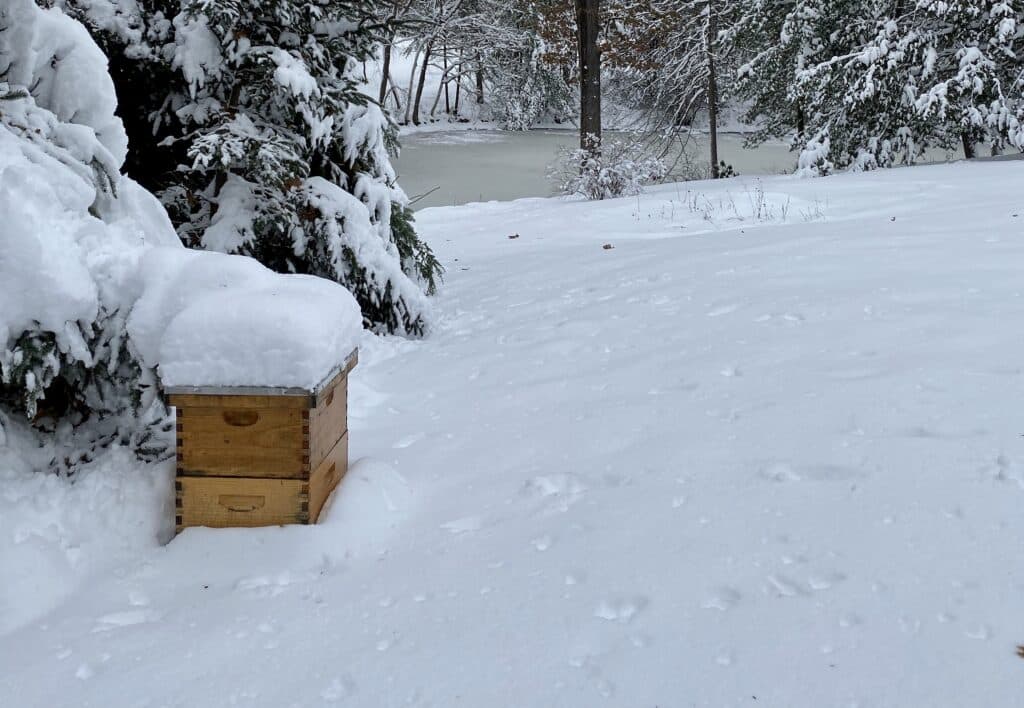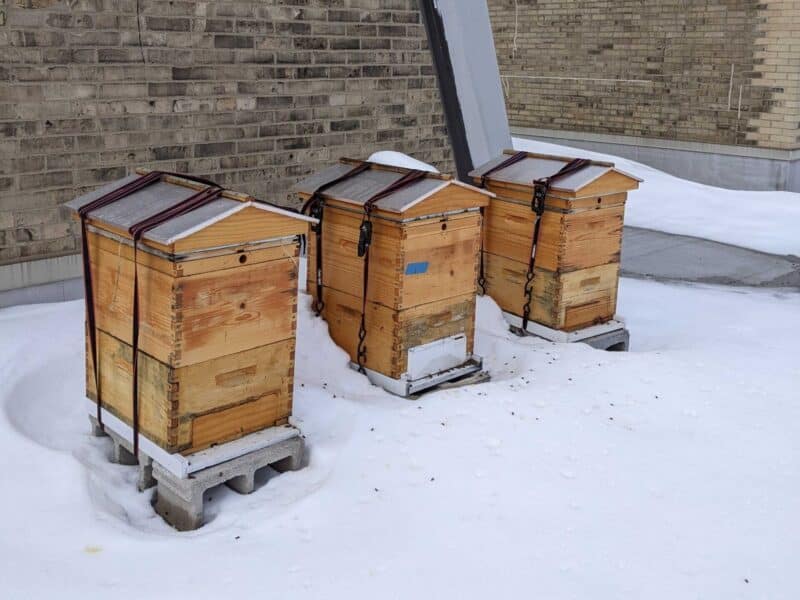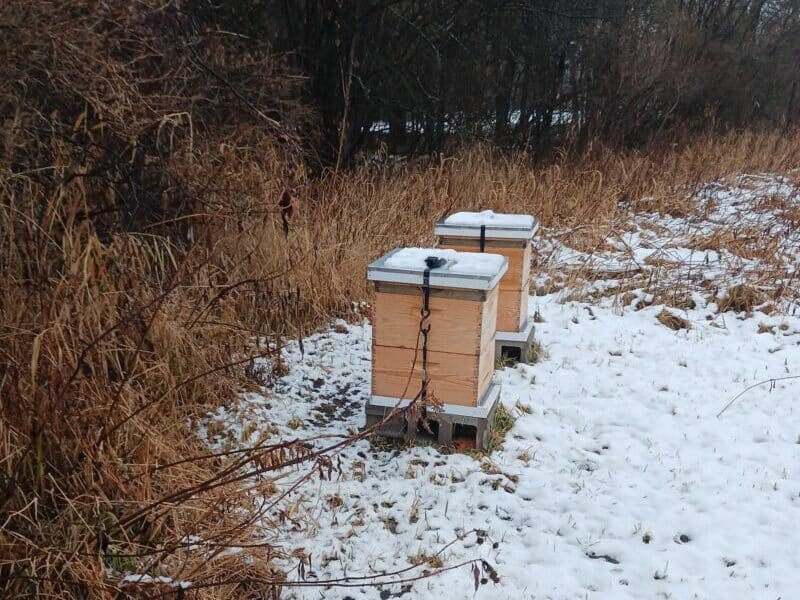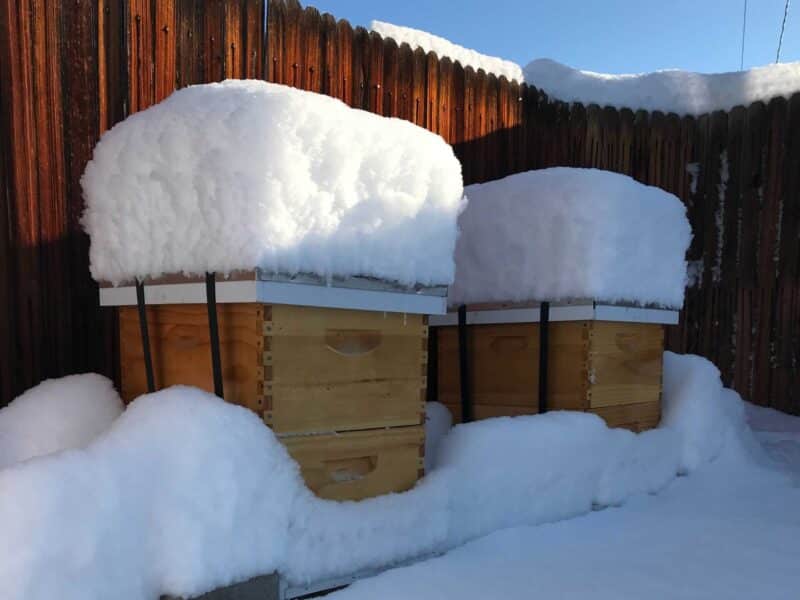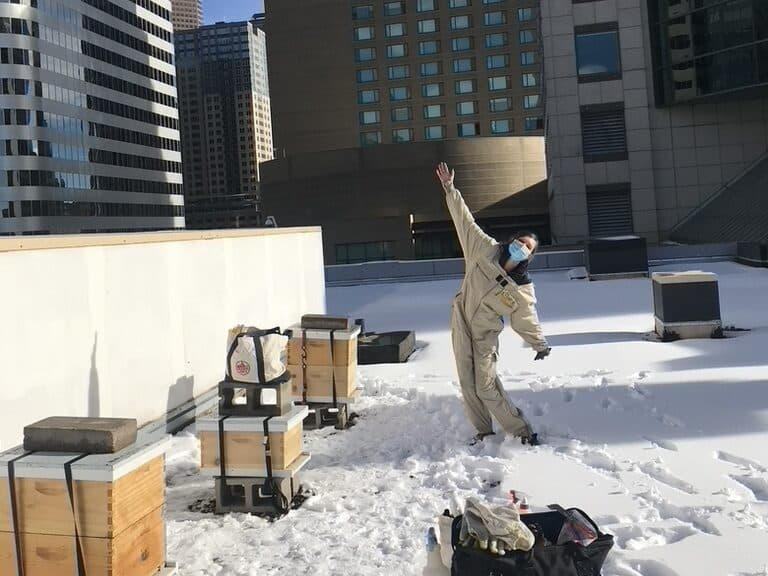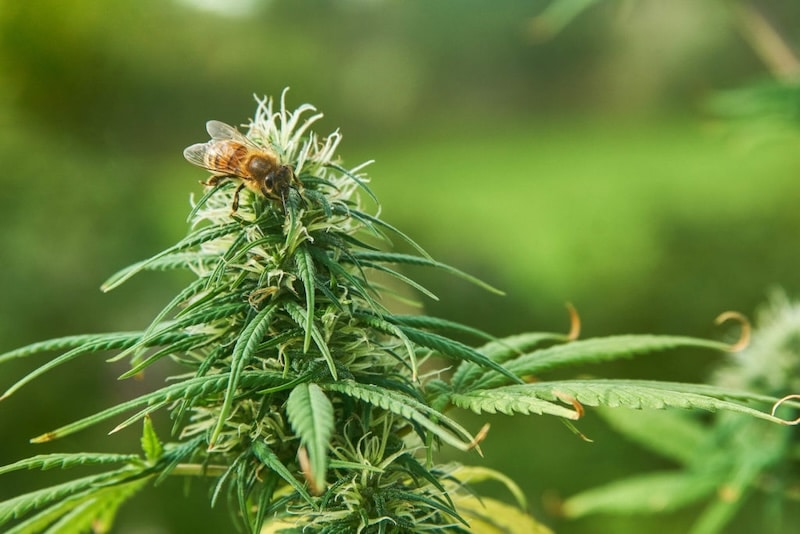Contents:
- What is Overwintering?
- What are Overwintering Rates?
- How Do Bees Prepare for Winter?
- What Do Bees Do in the Winter?
- What is the Difference Between Normal Worker Bees and Winter Bees?
- How Do Beekeepers Prepare for Overwintering?
- What do Beekeepers Do in the Winter?
- FAQs
What is Overwintering?
“Overwintering” refers to the process by which organisms pass through or wait out the winter. Migration is one kind of overwintering method, hibernation is another. Hibernation generally includes entry into diapause, a dormant state of lowered metabolism and decreased heart and respiratory rates. Bumble bees and carpenter bees hibernate over the winter – the mated females consume as much pollen and nectar as possible, find a suitable overwintering site (fallen logs, dry leaves, underground tunnels), and then enter into diapause until the spring.
Honey bees do not do this; instead, they stay active and overwinter inside their hives, creating their own heat source and relying on food stores they built up over the summer and fall.
What are Overwintering Rates?
When we talk about “overwintering rates”, we’re talking about the percentage of honey bee colonies in cold climates (where the temperatures between November and March typically range between an average high of 35 degrees F and an average low of 18 degrees F) that make it through the winter into the spring.
Over the winter of 2020–21, U.S. beekeepers reported average winter losses of 32.2%, with some states reporting losses as high as 58%. This was an increase of 9.6 percentage points over the previous winter loss rate (22.6%), and was 3.9 percentage points higher than the average winter loss (28.3%) reported by beekeepers over the previous 14 years, according to the Bee Informed Partnership’s National Colony Loss and Management Survey. This survey, which reports the data from thousands of beekeepers across the US, has monitored managed honey bee colony loss rates since 2007.
The winter of 2020-21 was a notably bad year for overwintering rates. Fortunately, the next year, over the winter of 2021-2022, an estimated 24.2% of managed colonies in the United States were lost. This represented an improvement of 9.3 percentage points over the previous winter loss rate (33.5%).
However, over the entire year (April 2021 – April 2022), beekeepers in the United States lost an estimated 39% of their managed honey bee colonies. This was only approximately one percentage point lower than the average loss rate (39.7%) over the last 11 years.
How Do Bees Prepare for Winter?
During the course of the spring and summer, honey bees amass stores of honey to provide nourishment during the winter. Productive hives will produce excess honey, which is good news for us! Here at Best Bees, we will only harvest honey the bees do not need.
In early fall, their queens slow down laying eggs and eventually stop laying altogether. The male drones are pushed out of the hive to limit the demand on the colony’s food supplies. This is called the expulsion of the drones.
When daytime temperatures fall below 57 degrees Fahrenheit, they retreat to their hives and cluster together around the queen, and next to their honey supplies, to stay warm as the temperatures outside get colder.
What Do Bees Do in the Winter?
When outside temperatures fall to 23 degrees, the bees on the inside of the cluster begin to vibrate their wings, generating heat to maintain an optimal temperature of 95 degrees within the cluster’s center, where the queen is located. A winter cluster is made up of an outside shell of bees around 3 inches thick that is very compressed. The bees’ heads face inward; within the center of the winter cluster, bees are less compressed and move around caring for the brood.
During the course of the winter, honey bees cycle between inner and outer layers, allowing near-frozen outer bees to rewarm, while their replacements take up position as living insulation on the clusters’ exteriors. It’s a highly efficient survival strategy that, under natural conditions, assures most colonies will survive until warm weather when new supplies of pollen and nectar reappear. There are a number of manmade and natural threats, though, that can impact hives’ ability to survive:
- Limited sources of pollen and nectar in late summer and fall can leave hives with stores of honey that are too small to feed them through the winter.
- A weak queen who produces small broods can mean there aren’t enough bees to generate the heat needed to survive extreme cold. Exposure to pesticides can have the same effect.
- Any unwanted moisture hives can bring hive temperatures down to dangerous levels.
- Parasite infestations—such as varroa mites—can weaken and kill enough bees to compromise their ability to stay warm.
What is the Difference Between Normal Worker Bees and Winter Bees?
In our article “Hive Hierarchy: Drone Bee, Worker Bee, and Queen Bee”, we discuss the three castes within a honey bee hive, the differences between their development, and the various roles and responsibilities they perform for the colony. What we don’t talk about in that article are the “winter bees”. These bees are so distinct from their sisters — both in structure and in function — that some scientists believe they constitute a fourth caste.
The technical name for these bees is “diutinus,” a Latin word that means “long lasting.” Normal worker bees live for about four to six weeks, while a queen bee can live for years. A substance called vitellogenin is credited with keeping the queen alive. Vitellogenin is produced in the fat bodies of bees and enhances immune function and increases lifespan.
The queen bee will lay the last eggs through September into early October. They are fed less protein than their warmer weather counterparts, due to the limited pollen resources. The bees that develop from these eggs are born with larger “fat bodies” – a nutrient rich, vital organ in the abdomen that acts as an energy storage center. A key product of the fat body is vitellogenin; the very same substance that gives queen bees their longevity.
These winter bees are physiologically different from normal worker bees. They live for months, and have lower metabolic rates, which means they do not need to consume as much food. All of these characteristics are advantageous to these bees for surviving through the winter.
How Do Beekeepers Prepare for Overwintering?
Today, more than 40% of northern colonies are compromised and don’t make it through the winter; without the help of professional beekeepers, the mortality rate would be much higher. Here are some tips and tricks from our expert beekeepers on preparing a beehive for the winter:
- Adjust The Position: Assess the positioning of the hive; while it’s not essential that it be perfectly level, there should be no discernable tilt, or moisture will build up in pockets. The bottom board must be tilted approximately 1-2 degrees downward, to allow moisture to drain away.
- Check The Weight: Hives are weighed to determine the volume of honey available for the winter, and to determine the frequency and volume of supplemental feeding required. You don’t need a scale for this— a simple lift will do.
- Feed Your Bees: Be sure that your beehives have enough honey to survive the winter. If not, supplement with fondant.
- Treat Your Hives: Dribble the cluster with Oxalic Acid. This is the final treatment to prevent varroa mite infestation for the year. With no capped brood left in the hive, varroa mites have nowhere to hide, and are easier to knock out. Beekeepers apply it in between the frames beginning with the bottom-most boxes that contain bees.
- Ventilate: Check to make sure there’s a large-notch inner cover in place, and that top ventilation is opposite from the bottom entrance to the hive. This will assure cross-ventilation, reducing the chance of deadly moisture build-up.
Through October and early November, our beekeepers visit as many as 50 beehives a day. Important housekeeping and data collection occur during these visits. The beekeepers assess each beehive’s population and record data on size, health, honey stores, activity and presence of a queen. Determining whether a queen is present can take careful examination of the entire hive. If she isn’t found, they’ll introduce a new queen into the hive.
Then, the beekeepers go through the inner contents, frame by frame, determining which are unused, meaning the wax combs are empty of nectar, pollen, honey or brood, removing all of these “blanks”. With the remaining, active frames, they’ll reorganize the beehive, placing the brood in the center, with space around them for honeybees to congregate and warm the beehive. They set up the built-out frames, containing wax comb and food stores, around the cluster of bees. This process often leads to consolidating down to one to two boxes.
If the beekeeper determines that the colony has more than enough honey stores for the winter, they’ll take out some full frames for harvesting. If supplies are low, they’ll give the colony one last feeding of sugar in liquid form.
One of the last steps is assuring proper ventilation — too open and the colony can freeze, too closed and water build-up from low ventilation can harm them. Beekeepers will reduce the bottom entrance and check on the size of the internal cover’s notch to assure proper ventilation. They will tip the beehive slightly to ensure any water build-up can drain out.
Checking for Varroa mites is a critical final step. Out-of-control Varroa mite infestations in winter can be fatal. To prevent infestations, beekeepers collect a sample of approximately 300 bees and perform an alcohol wash, observing the number of Varroa mites that settle to the bottom. If there are Varroa mites present at levels of 3% or more of bees, they mark for treatment during the last visit of the season.
What Do Beekeepers Do in the Winter?
The Best Bees cycle 10 experience is the last phase of our beekeeping calendar, marking our last chance for winter feeding and to inspect and clean out colonies that have not survived. While our process may differ from backyard beekeepers, there are still many similarities. Continue reading to learn more about our feed supply and hive assessment best practices during the winter period.
In order for us to understand what makes bees hardy and survive the winter, this late-winter assessment is fundamental for research purposes. For example, colonies flagged for Grafting and Splits will show a high likelihood of overwinter survival, hygienic behavior, high honey production, and a calm demeanor.
Supplying Feed to Bees in the Winter
Bees live off of a finite storage of honey during the winter. Many colder climate areas are without the plants and flowering blooms that provide nectar for the bees. To counter this, we feed low-resource colonies during the winter months to avoid the starvation of the colonies. These winter checks are brief to minimize the exposure of cold air that could possibly damage the cluster.
Because bees consume food faster closer to spring, our research has shown that the best way to support living colonies and bees coming out of the winter is through winter feeding, pollen patties, boosts, and adding splits. It is important to supply feed to bees so they do not starve before the nectar flow begins.
Winter Feeding Methods
There are many ways to feed a beehive in the winter:
Pollen patties: A pollen substitute that stimulates brood production.
Heavy stickies: Sharing frames from neighboring beehives that are rich with resources including nectar, pollen, and honey.
Honey-board: A unique method of feeding to the Best Bees Company. It’s where we essentially lay a blanket of honey on wax paper coated in sugar on top of the hive’s inner-cover.
Things Beekeepers Look For When Approaching a Hive in the Winter
When assessing a hive during the winter, there are a few things to consider when approaching the hive. We routinely look for and recommend keeping an eye out for the following signs of beehives that are alive:
- Bees flying close by (unlikely during very cold days)
- Melted snow around the hive (the heat of the cluster can melt surrounding snow, especially at the entrances)
- Dysentery streaks (bees relieve themselves over the side of the hive to avoid soiling their living space)
- Fresh dead bees on the landing board or ground in front of the hive (this is an indication that workers have been dragging out their dead even in winter).
Checking Hives in the Winter
This is a crucial period of time for survival and the colony should be disrupted as little as possible. Below are the Best Bees methodology for checking a live hive:
- Before you open the hive, feel the weight of the hive by gently lifting from the back of the bottom board. If it feels lighter than desired, prepare to feed.
- Assuming weather conditions are acceptable, gently lift the top cover only (leaving inner cover in place) and check for life through the hole in the inner cover and by listening.
- If alive and the hive feels light or the bees are right at the top, lay a honey board on top of the inner cover. Using a hive tool, gently poke a hole through the middle of the honey-board and into the hole in the inner cover, creating access for the bees to feed.
Note: If temperatures are warm enough, you may be able to open the hive up a little more. In this case, consider adding heavy stickies for the bees to enjoy.
- Place the top cover back on, making sure not to obstruct existing ventilation. This is a good time to make sure it is still properly ventilated.
- Clear fallen bees from the bottom entrance so that they can continue to remove dead bodies and make cleansing flights.
Overwintered beehives can be hard to spot! Before you clean out a hive you deem dead, make sure you are certain. Here are some tips to help.
- If the cluster is motionless, remove some bees from the outside of the cluster and try warming them up in your hands. If they don’t revive, the colony is most likely dead.
- Bees with their tongues out can be an indication that they are dead.
Whatever happens to your bees this winter, don’t give up. Successful beekeeping takes many years of practice. You’ll face new challenges every year, and through them, you’ll grow smarter and your bees will grow stronger and healthier!
FAQs
Q: What do bees do in the winter?
A: Honey bees stay active during the winter, clustering around the queen to keep her warm and eating through stored honey resources from the summer and fall.
Q: Do bees hibernate?
A: No, honey bees do not hibernate. They are active during the winter.
Q: Why do winter bees live longer than normal worker bees?
A: Winter bees have larger fat bodies and lower metabolisms.
Q: Do beekeepers open hives during the winter?
A: Beekeepers do not typically open hives in the winter, to keep the hive warm. If it is necessary to open the hive in order to supply the bees with food, then it is done as quickly as possible.


